|
FRESH STUFF DAILY |
|
|
||
|
|
||
|
|
||
|
SEE ALL SIGNED BOOKS by J. Dennis Robinson click here |
||
Much has been made of the patriotic soldiers of Massachusetts and Connecticut at the Battle of Bunker Hill. But check the stats. New Hampshire men arrived in greater number and fought powerfully. History books often miss this perspective.
SEE: LIVE pictures of Bunker Hill in NH Now, in June of 1775, this motley collection of "rabble in arms," loosely disciplined, ill equipped and unsure of their fighting capabilities, was about to confront the cream of the British fighting forces.
About six pm on the evening of June 16, troops from Massachusetts and Connecticut marched from Cambridge to occupy Breeds Hill, over looking Boston harbor. Bunker Hill had been their destination according to orders, but the other hill seemed to offer a better position for fighting, and it was selected as the site of fortifications. Under the directions of Col. William Prescott, the soldiers constructed a redan or arrow-shaped redoubt. They finished shortly before dawn and had rested only a short time before their work was discovered by the British, one of whose ships, HMS Lively, opened fire from the harbor. With the daylight, Prescott could see that both his flanks were unprotected and the soldiers began working again, especially on the left. At least one man was killed by the naval firing, and others, tired and hungry, began to have apprehensions about their fate. Behind the redoubt, the rebel position was rimmed by a 600-foot rail fence which sloped toward the Mystic River. It was defended by Capt. Knowlton and 200 Connecticut militia. In the empty space between the redoubt and the fence, six pieces of artillery had been placed, but were rendered useless by lack of proper ammunition. Knowlton's men quickly did what they could. They gathered hay, dismantling the neat cocks and piles of the first mowing of the season. With this they "upholstered" the fence as best they could. Prescott was sensitive to the tenuousness of his position. He sent a messenger to Gen. Ward for much needed supplies and reinforcements. Shortly after noon, a contingent of New Hampshire troops from Stark's regiment arrived under Lt. Col. Wyman. They were detailed to fill in gaps in the redoubt at the top of the hill. New Hampshire regiments under the commands of Col. Stark and Col. Reed were also summoned from Medford. Our Troops Arrive
Capt. Henry Dearborn's company was first in the order of march. He was walking beside Stark and suggested they quicken the pace. Stark fixed him with a steely gaze and replied. "Dearborn, one fresh man in action is worth ten fatigued ones," and continued his slow, deliberate gait. One of the regiments which had been halted was Reed's. It immediately fell in behind Stark's troops, with Lt. Col. Gilman in command, Reed being away sick. The soldiers followed the open road up over the grassy knoll of Bunker Hill, where they encountered Israel Putnam and his Connecticut troops. Upon reaching the top of the hill, Stark issued orders to take up one of two fences which ran parallel with the river and to stuff hay between the rails. He also ordered the construction of a low, short, stone wall between the end of the rail fence and the edge of the Mystic River. When Reed's men arrived, they took positions to Knowlton's left and began to fortify the fence in a similar manner. Stark positioned his troops to Reed's left strengthening Prescott's left flank. On the British side of the river, the decision to mount a frontal assault in the "best traditions of the European battlefield" had already been made. It was assumed, of course, that the rebel troops consisted universally of "scoundrels" and "cowards" who would flee after the first bayonet charge. The logistics of mounting an amphibious assault were tricky, however, so although the decision was made quickly, considerable time elapsed between it and the actual attack. From the vantage point of Bunker Hill, raw American troops were treated to an unfolding diorama as 28 barges of disciplined figures arrayed in brilliant color glided rhythmically toward Morton's Point. Flashing oars, polished brass field pieces, oiled metal, gleaming match boxes reflected the warm June sun. In command of this awesome symmetry was Gen. Howe. On landing, he immediately sent back for additional troops and allowed his men to break ranks for a late lunch. In the American camp. raw recruits faced the coming reality of battle. Bells began to peal in Charlestown and drums beat in assembly and alarm. Col. Stark saw his opportunity to deliver a ". . . short animated address" and was rewarded with three rousing cheers for courage. By now, the British had begun to use the incendiary cannon balls. Charlestown was in flames! It was mid-afternoon and the moment of truth had come for both sides. The Patriots-many dirty, hungry and tired, and all tense and expectant- awaited the onslaught of the famed British war machine. Brittish Attack
The murderous effect of the rebels' fusillade along the Mystic River front is well described by Richard M. Ketchum in his book, Decisive Day: The Battle for Bunker Hill (Doubleday): . . . a row of dull musket barrels leveled along the stone wall, a nasal New England voice twanged and the wall disappeared in a sheet of flame and oily b1ack smoke. The blurt of fire tore apart the leeding ranks of Fuseliers and as the rows behind closed up they were shattered by the violent hail of bullets. Officers fell, men spun around and dropped headlong into the shallow water, and the column stopped, recoiled, then came on again. The King's own regiment showing through the broken Fuseliers clambering over the dead and wounded only to be met with that withering fire from the wall. Officers' voices shouted hoarsely through the din, ordering the men forward, but with each advance the men in the lead simply melted away, falling grotesquely and piling up the awful carnage on the narrow heach until there was nothing to do but turn back. The British stormed again, but with that attempt came another deadly failure. Howe was, by this time, almost entirely bereft of officers. The 35th regiment, for example. had only six men left, and no leadership. He looked for an opening and decided to attack the space between the redoubt and the fence, using 400 reinforcements recently arrived from Boston. The rebels tried to repulse the attack by firing nails, having used up their supply of powder and shot. They even threw rocks in an attempt to dislodge the long rows of Brown Besses which marched steadily onward. Finally, they were forced to retreat. Knowlton, Stark and Reed protected the withdrawal, sustaining heavier losses than before. The pullback was orderly, with only 31 Colonials falling into the hands of the British. By 5:30 the battle for Bunker Hill was over. NH "Rules"
Much has been written of the heroism demonstrated by the men of Massachusetts at the Battle for Bunker Hill, but New Hampshire's role in that great Patriot undertaking has been minimized or at least under-publicized. More than 100 men from New Hampshire were in Col. Prescott's Massachusetts Regiment, for example, including a company of 59 men under Capt. Dow from Hollis. The manifest of Col. Reed's regiment dated June 14, 1775, two days before the battle, lists 637 men of whom 448 were fit for duty. A similar document dated July 2, 1775 indicates that Col. Stark drew rations for 679 men. Adding the 60 from Stark's regiment who fell at Bunker Hill, we arrive at the impressive total of 739. While we probably will never know the exact number of New Hampshiremen who served at Bunker Hill, it is reasonable to assume the figure is somewhere in the neighborhood of 1000 to 1300, virtually all the men New Hampshire had available. In any event, the New Hampshire contingent outnumbered the combined totals of Massachusetts and Connecticut. The Rev. Increase N. Tarbox, in his life of Gen. Putnam, wrote, "We have the full conviction that the time will come when the whole nation will give the honors of the battle of Bunker Hill largely to the common soldiers of New Hampshire who more than any other men, fought it....'' SOURE: Originally published in "NH: Years of Revolution," Profiles Publications and the NH Bicentennial Commision, 1976. Reprinted on SeacoastNH.com in 1997 by permission of the authors. Please visit these SeacoastNH.com ad partners.
News about Portsmouth from Fosters.com |
| Thursday, April 18, 2024 |


|
Copyright ® 1996-2020 SeacoastNH.com. All rights reserved. Privacy Statement
Site maintained by ad-cetera graphics

 Smuttynose Murders
Smuttynose Murders



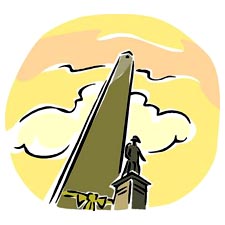
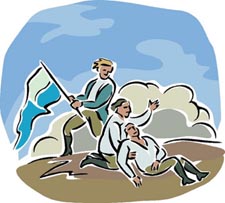 Col. Stark had been given command of the First New Hampshire Regiment, while James Reed and Enoch Poor led the Second and Third. Stark, by virtue of both his reputation and personality, commanded 12 companies. Reed and Poor commanded ten each, but Poor and his regiment remained in New Hampshire.
Col. Stark had been given command of the First New Hampshire Regiment, while James Reed and Enoch Poor led the Second and Third. Stark, by virtue of both his reputation and personality, commanded 12 companies. Reed and Poor commanded ten each, but Poor and his regiment remained in New Hampshire.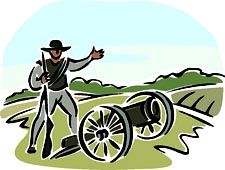 As the New Hampshire troops approached Charlestown Neck, they encountered two regiments which had been halted by bar and chain shot, accurately delivered by the guns of the British ships and barges. At this point, Maj. Andrew McClary requested that the New Hampshire regiments be allowed to pass.
As the New Hampshire troops approached Charlestown Neck, they encountered two regiments which had been halted by bar and chain shot, accurately delivered by the guns of the British ships and barges. At this point, Maj. Andrew McClary requested that the New Hampshire regiments be allowed to pass.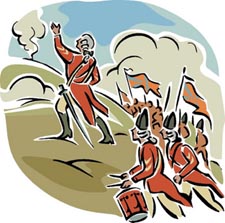 Along the beach and through the swamp on their left, Howe's 5th, 2nd and Grenadiers moved forward in disciplined ranks. The assault was spearheaded by Gen. Pigot with the 38th, 43rd and Grenadiers, and on the other flank the 47th and the Royal Marines. As cannons ceased firing, rebels peering over the breastwork could hear hardware clanking against marching legs, the crackling of uncontrolled fires in Charlestown and the pounding of their own hearts and temples. Muffled orders to fire startled many back to reality and the knowledge that the enemy was now less than 50 feet away. The order to fire rang out.
Along the beach and through the swamp on their left, Howe's 5th, 2nd and Grenadiers moved forward in disciplined ranks. The assault was spearheaded by Gen. Pigot with the 38th, 43rd and Grenadiers, and on the other flank the 47th and the Royal Marines. As cannons ceased firing, rebels peering over the breastwork could hear hardware clanking against marching legs, the crackling of uncontrolled fires in Charlestown and the pounding of their own hearts and temples. Muffled orders to fire startled many back to reality and the knowledge that the enemy was now less than 50 feet away. The order to fire rang out.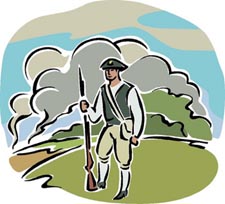 One thousand fifty-four of the 2300 British who had greeted the day with confidence and whole bodies would never do so again. On the American side, estimates have varied. George Washington, for example, has left us the number 450 dead, missing and wounded. New Hampshire regiments reported 74 wounded and 19 missing In any event, it was a Pyrrhic victory for the British, for on that afternoon something died in the cream of the British soldiery.
One thousand fifty-four of the 2300 British who had greeted the day with confidence and whole bodies would never do so again. On the American side, estimates have varied. George Washington, for example, has left us the number 450 dead, missing and wounded. New Hampshire regiments reported 74 wounded and 19 missing In any event, it was a Pyrrhic victory for the British, for on that afternoon something died in the cream of the British soldiery.














